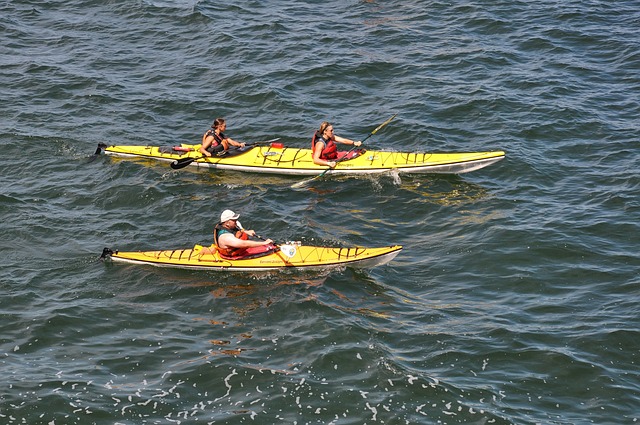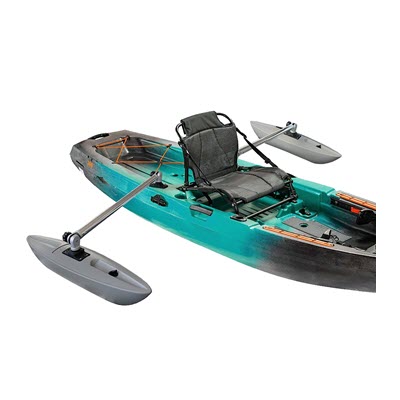One of the parts of kayaking that tends to make novices a bit nervous is the possibility of tipping over. Luckily, if your kayak is feeling a little on the unstable side, there are steps that you can take to make it feel much steadier and remain upright to enjoy your next day on the water. In this article I’ll explain how to make a kayak more stable, and I’ll also explain the different factors that impact a kayak’s stability including hull width, shape, and your paddling form and posture.
Why Kayaks Feel “Tippy”
Before we work on how to make a kayak more stable, it’s important to determine why your kayak is feeling unstable.
Two of the most common causes of kayak instability are:
- You could be using the wrong shape or type of kayak for the activity you’re participating in, or
- You might have weight unevenly distributed within your kayak.
A common misconception is that all kayaks feel unstable in the water and that’s just the nature of kayaking as a sport.
This isn’t true.
If you find that you feel unsteady whenever you hit the water in your kayak, you may have the wrong type of kayak, poor form, or you just need to balance the weight.

Let’s dig a little deeper to see if there’s a way to fix your kayak’s stability issue without buying something (a free solution is always better, right?).
Factors that Impact Your Kayak’s Stability
The reason for the instability you’re experiencing with your kayak could extend all the way back to when you chose and obtained your craft.
I always recommend that you do your homework before buying a kayak and are sure that you’re purchasing a kayak that suits your specific needs. Before beginning to shop for a kayak, decide on what it is that you want to do with it. Every type of kayak is designed for a different type of paddling. Most sales reps will steer you in the right direction so you have a good experience and return to their shop for more gear down the road.
For example, if you want to go for relaxing and leisurely trips on the water, you should look for a model that is wider.
If you’re an experienced kayaker and want to prioritize speed and agility, you will need a model that is leaner in shape and therefore allows for quicker movement on and through the water.

You will also have to consider the kind of water you’ll be traveling on. If you will be traveling on very serene waters and just want a quiet and natural way to leisurely explore the lakes and streams around your home, I recommend that you purchase a touring kayak with a wide bottom.
However, you’d be really dissatisfied if you bought a wide touring kayak for use on a river with fast-moving waters, and this type of kayak can be frustrating to paddle in the ocean as well.
Three Factors that Affect Kayak Stability
There are three features of a kayak that determine its stability. These include:
- The shape of the hull: The way the hull of your kayak is shaped should fit the intended uses of the craft. For instance, if you’re traveling on waters that call for a kayak to stay upright pretty much on its own, you will often want to look for a flat hull. This kind of hull, however, will be inappropriate if you want to really ride the water’s waves, or need to slice through rough current or against a tide or strong wind.
- The kayak’s overall width: The width of your kayak is often considered the most important factor that determins how stable a kayak will be. In general, the greater a kayak’s width, the more superior its buoyancy and the more difficult it will be to tip or roll your kayak. With greater surface area, the boat won’t end up swaying as dramatically and your yak will remain upright in the water with ease.
- How weight is distributed: Once you have the kayak, keep in mind that the weight distribution of the people and items in the kayak will also affect stability. Make sure that there isn’t an excessive amount of weight in one area of the boat. You want balance in your kayak, no matter its width or shape. That means you should balance the weight front and back, and side to side. Not only will this make your kayak more stable, it will make it more easy to paddle and maneuver in the water.
What to Do if You’re a Beginner
If you’re brand new to using a kayak, I recommend purchasing and learning on a wide, touring kayak. You don’t want to paddle around on a lilly-pad, so get one with a hull that is stream-lined, but start out with a wider, more stable kayak.
Also make sure that you learn to paddle your kayak correctly.

Failing to paddle in the appropriate way can quickly lead to problems with instability (and it’ll make you sore, which will make you hate kayaking).
Take a course with an instructor and make sure there’s some practice in balancing on your kayak as part of that course.
If you don’t paddle in the correct way, you will also experience problems such as the kayak pulling off in one direction. This makes you correct your course constantly, which slows you down and makes your trip less efficient.
Steps You Can Take to Improve Your Kayak’s Stability
In some cases, you may already have a kayak that is just right for your needs and lifestyle, but you may still be having problems with stability.
In this case, I recommend trying the approaches below to help improve the stability of your kayak
How to Improve Kayak Stability for Free
- Adjust your seat to a lower height: Sitting lower in your craft can help a great deal with the stability of your kayak. Lowering your seat can create a stronger center of gravity. This will make you feel more secure as you make your way through the water. While sitting lower may affect your paddling a little bit, the benefits make this worth the trade-off if you are feeling tippy and insecure in your boat.
- Fix the weight distribution: If there is too much weight in one part of your kayak, it will probably start wobbling and feeling unstable. Ensure that you’ve distributed your gear evenly throughout the kayak. It’s possible that you might need to add a bit more weight to a part of your kayak as well. If you purchased a narrow kayak, consider adding a bag of sand to the bow and stern storage areas to help your craft sit lower in the water.
- Be even more attentive about weight if you’re in a two-seater: If you have a two-seat (or tandem) kayak, you will probably have to be even more careful about weight distribution. If one person in the kayak is heavier than the other, it can lead to issues with stability. You can try to resolve this by adding extra weight to the part of the kayak that holds the lighter individual.

Other Ways to Make Your Kayak More Stable
- Invest in a stabilizer: You could consider buying a stabilizer for your kayak like this one with great reviews on Amazon. These stabilizers (called kayak outriggers) feature long arms which attach to a flotation buoy on one or both sides of your boat that help create better balance in the water. If you feel like you’ve tried all the other approaches to improving stability and you’re still feeling wobbly, this is an avenue to pursue. These can be attached temporarily, so they can be used while learning to kayak, or on rough water, and removed as you gain experience.
- Think about using a different kayak: If you still can’t make your kayak more stable, you could consider trying a different model. It’s possible that a different kayak (one that’s wider, or has improved buoyancy) will be the right one for you. There’s no shame in admitting you bought the wrong boat and it’s better to fix the problem than to give up on the sport altogether. When you buy a new model, ensure that you do a demo before making a commitment to purchase. You don’t want to purchase a dud again!
That’s How to Make a Kayak More Stable
While instability in your kayak is an annoying problem, there are ways to resolve it.
Some of these methods are simple (and free), others require an investment in a kayak outrigger, and as a last resort, you may want to change to a more stable kayak.




